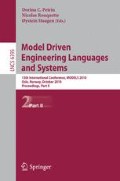Abstract
Lean and Agile processes have resolved longstanding problems in engineering communication by replacing document based communication with face-to-face collaboration, but do not yet scale to very large and heterogeneous projects. This paper proposes a compatible extension to lean and agile processes that addresses this limitation. The core idea is to adopt the view of documentation as boundary objects: shared artefacts that maintain integrity across a project’s intersecting social worlds. The paper presents a case study, in which interviews with system engineers and designers were analysed to obtain requirements on an architectural description serving as boundary objects in a telecommunications project. The main result is a list of 18 empirically grounded, elementary requirements, worth considering when implementing lean and agile processes in the large.
Access this chapter
Tax calculation will be finalised at checkout
Purchases are for personal use only
Preview
Unable to display preview. Download preview PDF.
References
Lindvall, M., Muthig, D., Dagnino, A., Wallin, C., Stupperich, M., Kiefer, D., May, J., Kahkonen, T.: Agile Software Development in Large Organizations. IEEE Computer 37(12), 26–34 (2004)
Abrahamsson, P., Warsta, J., Sippon, S.T., Ronkainen, J.: New Directions on Agile Methods: A Comparative Analysis. In: Proceedings of the 25th International Conference on Software Engineering, pp. 244–254. IEEE Computer Society, Washington (2003)
Mehta, M., Anderson, D., Raffo, D.: Providing Value to Customers in Software Development Through Lean Principles. Software Process: Improvement and Practice 13(1), 101–109 (2008)
Poppendieck, M., Poppendieck, T.: Lean Software Development: an Agile Toolkit. Addison-Wesley, Boston (2003)
Poppendieck, M., Poppendieck, T.: Implementing Lean Software Development: From Concept to Cash. Addison-Wesley, Upper Saddle River (2007)
Tomaszewski, P., Berander, P., Damm, L.O.: From traditional to streamline development - opportunities and challenges. Software Process: Improvement and Practice 13(2), 195–212 (2008)
Petersen, K., Wohlin, C.: A Comparison of Issues and Advantages in Agile and Incremental Development Between State of the Art and an Industrial Case. Journal of Systems and Software 82(9), 1479–1490 (2009)
Star, S.L., Griesemer, J.R.: Institutional Ecology, ‘Translations’, and Boundary Objects: Amateurs and Professionals in Berkeley’s Museum of Vertebrate Zoology, 1907-39. Social Studies of Science 19(4), 387–420 (1989)
Subrahmanian, E., Monarch, I., Konda, S., Granger, H., Milliken, R., Westerberg, A.: Boundary Objects and Prototypes at the Interfaces of Engineering Design. Computer Supported Cooperative Work 12(2), 185–203 (2003)
Lutters, W.G., Ackerman, M.S.: Beyond Boundary Objects: Collaborative Reuse in Aircraft Technical Support. Computer Supported Cooperative Work 16(3), 341–372 (2007)
Pawlowski, S., Robey, D., Raven, A.: Supporting Shared Information Systems: Boundary Objects, Communities, and Brokering. In: 21st International Conference on Information Systems, pp. 329–338. Association for Information Systems, Atlanta (2000)
Phelps, A.F., Reddy, M.: The Influence of Boundary Objects on Group Collaborationin Construction Project Teams. In: Proceedings of the ACM 2009 International Conference on Supporting Group Work, pp. 125–128. ACM, New York (2009)
de Paula, M.G., Barbosa, S.D.J.: Investigating the Role of a Model-Based Boundary Object in Facilitating the Communication between Interaction Designers and Software Engineers. In: Winckler, M., Johnson, H., Palanque, P. (eds.) TAMODIA 2007. LNCS, vol. 4849, pp. 273–278. Springer, Heidelberg (2007)
ANSI/IEEE Std 1471 :: ISO/IEC 42010 - Systems and Software Engineering - Recommended Practice for Architectural Description of Software-Intensive Systems. International Standard, ANSI/IEEE (2007)
Yin, R.K.: Case Study Research: Design and Methods. Sage Publications, Thousand Oaks (2003)
Pareto, L., Eriksson, P., Ehnebom, S.: Concern Visibility in Base Station Development: an Empirical Investigation. In: Schürr, A., Selic, B. (eds.) MODELS 2009. LNCS, vol. 5795, pp. 196–210. Springer, Heidelberg (2009)
Pareto, L., Staron, M., Eriksson, P.: Ontology Guided Evolution of Complex Embedded Systems in the Direction of MDA. In: Czarnecki, K., Ober, I., Bruel, J.-M., Uhl, A., Völter, M. (eds.) MODELS 2008. LNCS, vol. 5301, pp. 874–888. Springer, Heidelberg (2008)
Pikkarainen, M., Haikara, J., Salo, O., Abrahamsson, P., Still, J.: The impact of agile practices on communication in software development. Empirical Software Engineering 13(3), 303–337 (2008)
Karlström, D., Runeson, P.: Combining Agile Methods with Stage-Gate Project Management. IEEE Software 22(3), 43–49 (2005)
Lindvall, M., Muthig, D., Dagnino, A., Wallin, C., Stupperich, M., Kiefer, D., May, J., Kahkonen, T.: Agile software development in large organizations. IEEE Computer 37(12), 26–34 (2004)
Pikkarainen, M., Haikara, J., Salo, O., Abrahamsson, P., Still, J.: The impact of agile practices on communication in software development. Empirical Software Engineering 13(3), 303–337 (2008)
Author information
Authors and Affiliations
Editor information
Editors and Affiliations
Rights and permissions
Copyright information
© 2010 Springer-Verlag Berlin Heidelberg
About this paper
Cite this paper
Pareto, L., Eriksson, P., Ehnebom, S. (2010). Architectural Descriptions as Boundary Objects in System and Design Work. In: Petriu, D.C., Rouquette, N., Haugen, Ø. (eds) Model Driven Engineering Languages and Systems. MODELS 2010. Lecture Notes in Computer Science, vol 6395. Springer, Berlin, Heidelberg. https://doi.org/10.1007/978-3-642-16129-2_29
Download citation
DOI: https://doi.org/10.1007/978-3-642-16129-2_29
Publisher Name: Springer, Berlin, Heidelberg
Print ISBN: 978-3-642-16128-5
Online ISBN: 978-3-642-16129-2
eBook Packages: Computer ScienceComputer Science (R0)

